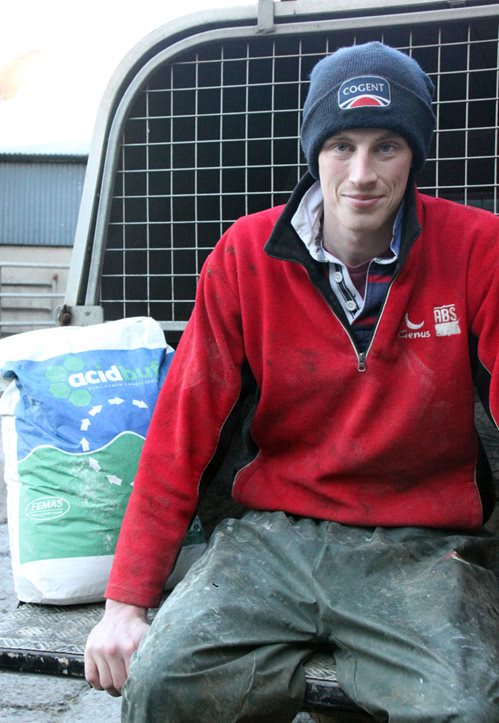Attention to detail makes the difference for County Antrim dairy herd
Published Tuesday, 19th September 2017
For young Lisburn-based dairy farmer, David Simpson, keeping a close eye on the dietary intake of his high-yielding cows is key to the successful growth of his family’s dairy herd.
Despite being just 23 years of age, David Simpson has big ambitions to build on the recent growth of his family’s dairy herd. By focusing on the technical aspects of cow management and taking professional nutritional advice, David has successfully maximised his herd’s yield, fertility and overall cow performance.
David’s family farm a total of 400 acres in County Antrim. The farm’s dairy facilities were renovated in 1998, but a few years later the herd went out of production due to an outbreak of Brucellosis. The herd has subsequently been rebuilt, with David being the driving force behind its expansion to 130 cows.
“We restarted in milk production with 80 in-calf heifers four years ago,” David explains. “That coincided with me returning to the family business following the conclusion of my time at Greenmount College. Since then, we’ve been focusing on building cow numbers, paying particular attention to nutrition in order to maximise fertility and productivity.”
Amongst the changes made to the way the new herd is managed are the introduction of three times a day milking and the use of a feeder wagon, which allows the herd to receive a TMR ration.
Unlocking high yields
“We went to three times a day milking in January 2014 and almost instantly saw a jump in daily milk production from 28 litres per cow to over 35 litres,” David describes. The herd is currently averaging more than 9,000 litres per lactation, with nutrition one of the keys to unlocking the herd’s high yields.
Of the farm’s 400 acres, 200 are put to grass, 150 to cereals and 50 to potatoes. “We’re slowly reducing the acreage of potatoes so that we can focus on producing enough forage for the dairy cows which are housed all year round,” David adds. “We used to grow some maize to complement the grass silage, but stopped a few years ago following a succession of wet harvests. Instead, we now grow as much grass silage as possible and supplement that with whole-crop cereals.”
The home-grown crops are used to create a TMR diet which is formulated by Lyle Hamilton of Farmgate Nutrition. “We started working with Lyle 12 months ago because we recognised there was room for improvement in the way we were feeding the cows,” David explains. “He samples our grass silage every two or three months and tells us how to adjust the current ration according to the latest set of test results.”
The main ration comprises a mixture of 1st, 2nd and 3rd cut grass silage, straw, dairy blend, rolled wheat, minerals, a mycotoxin inhibitor and Acid Buf – an acid-neutralising rumen buffer.
“The overall breakdown of the diet’s ingredients can change from month to month according to the quality of the silage being fed,” David adds. “We can normally produce dry, leafy silage with plenty of energy, but last year’s wet weather meant we ended up with a clamp of wet silage with a high acid loading.
“As a result, we felt Sub Acute Ruminal Acidosis (SARA) could be more of a problem and the cows were also exhibiting higher levels of cud-balling (spitting out their cud) because the silage was too acidic. That can be an indication of SARA when cows are on wet acidic silage, so we spoke to Lyle to see what he recommended.”
Combating acid loading
In order to combat the silage’s high acid loading, Acid Buf was introduced to the TMR ration. The sea-algae based rumen conditioner has a high capacity to neutralise acid and contains bio-available calcium and magnesium to promote and protect rumen.
“The amount of Acid Buf we uses varies according to the last silage analysis,” David continues. “Since we started using it in the summer, the cows have almost completely stopped cud-balling. It has also helped to improve feed conversion efficiencies and we have also seen a slight improvement in herd fertility.
“We’re convinced the Acid Buf has made a huge difference – particularly given the relatively poor quality of this year’s silage – and has helped to keep the vet away by preventing acidosis from becoming a major issue.”
Derek McIlmoyle, Technical Director for AB Vista who distribute Acid Buf in Ireland, recommends that herds fed a predominantly grass silage based diet should receive a rumen conditioner as a matter of course. “Cud-balling can be a common problem amongst high yielding dairy cows especially in Northern Ireland when wet and acidic grass silage is the sole forage in the diet,” he explains.
“It is a sure sign that cows may be struggling with the acid load, but cows that display this signal are just the tip of the iceberg. Many more don’t show obvious signs of early onset acidosis and as such are at risk of reduced rumen productivity. For total peace of mind, it is advisable to use a rumen conditioner as a matter of routine, especially in high yielding grass silage fed herds.”
Latest news
Stay ahead with the latest news, ideas and events.

Online Feed Fibre Calculator
Calculate the percentage of dietary fibre in your feed
Our calculator is designed for nutritionists and uses averages of global raw materials to calculate the dietary fibre content (plus other more in-depth fibre parameters) of finished animal feed. These parameters are available within AB Vista’s Dietary Fibre analysis service (part of our NIR service).
Sign up for AB Vista news
A regular summary of our key stories sent straight to your inbox.
SUBSCRIBE© AB Vista. All rights reserved 2025
Website T&Cs Privacy & Cookie Policy Terms & Conditions of Sale University IDC policy Speak Up Policy
























